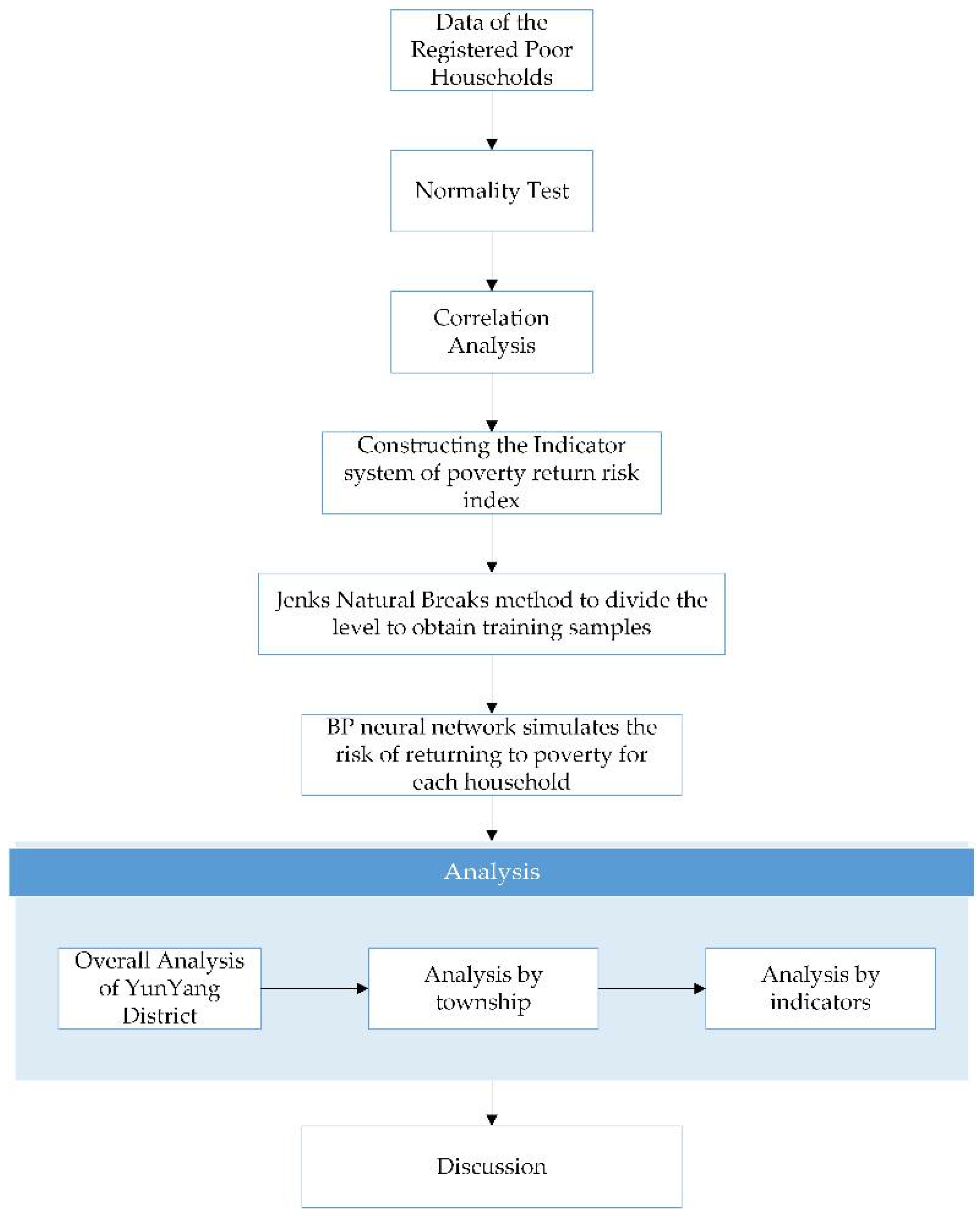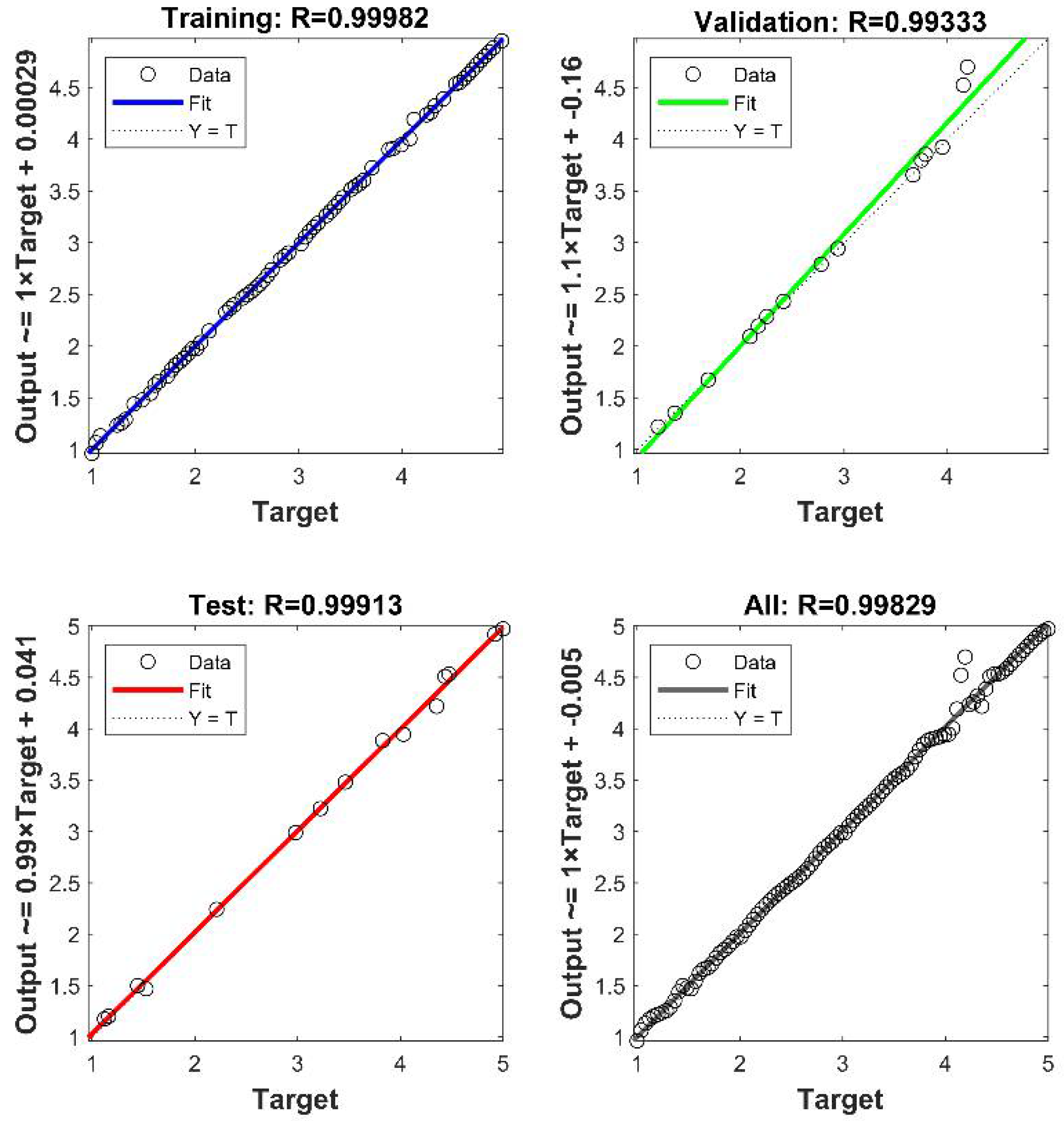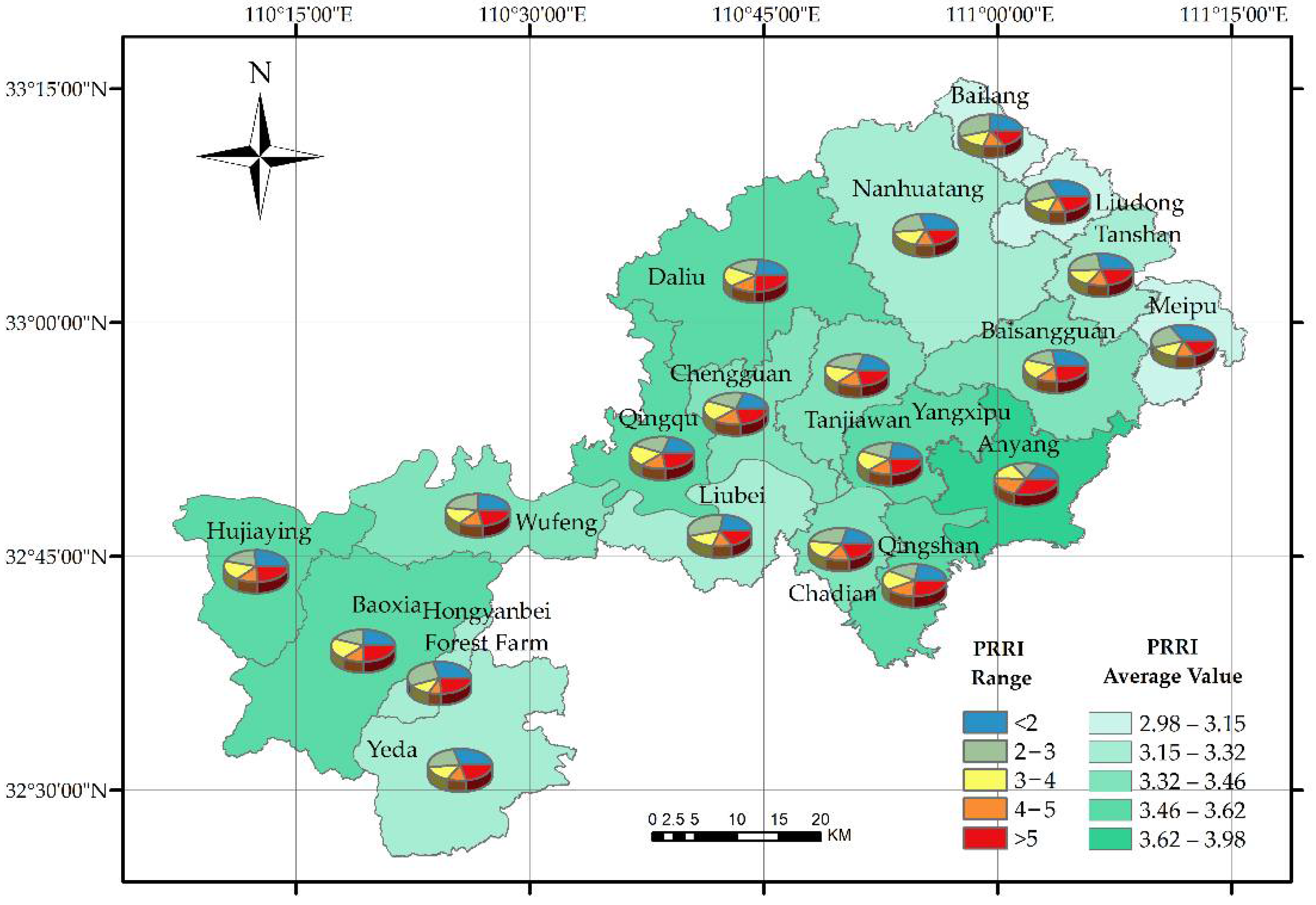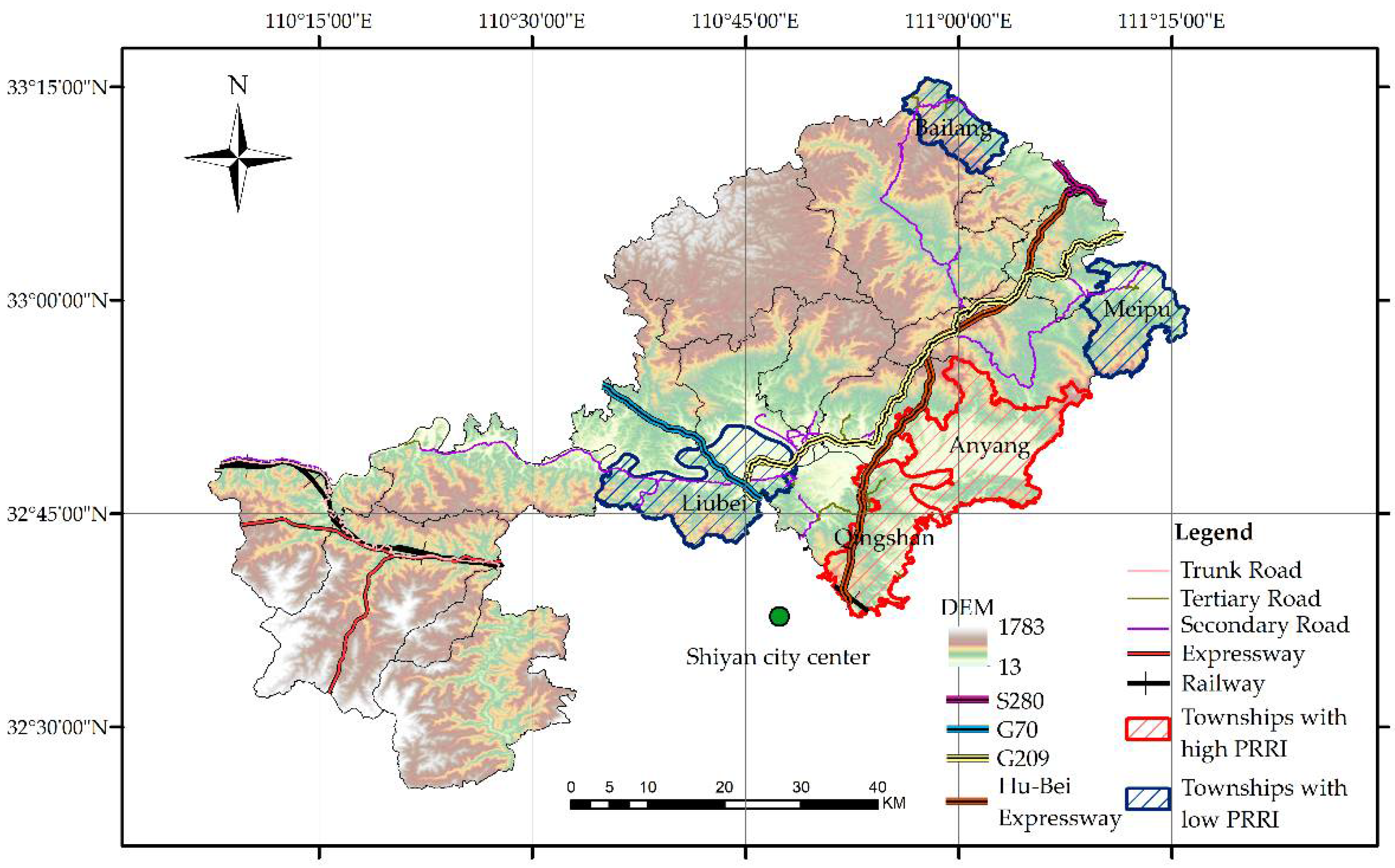Poverty-Returning Risk Monitoring and Analysis of the Registered Poor Households Based on BP Neural Network and Natural Breaks: A Case Study of Yunyang District, Hubei Province
Abstract
:1. Introduction
2. Research Review
3. Materials and Methods
3.1. Technique Route and Research Analysis
3.1.1. Technique Route
3.1.2. Research Analysis
3.2. Overview of the Study Area
3.3. Data Source and Pre-Processing
- 1.
- The household labor force mean score: the ratio of the sum of labor force scores in households to the number of people in households
- 2.
- The number of people in the household
- 3.
- The mean age in household: the ratio of the total age of each household member to the total number of household members
- 4.
- The household education status mean score: the ratio of the sum of education status scores in households to the number of people in households
- 5.
- The past poverty determination mean score of the registered poor households
3.4. Indicators Selection
3.5. Methods
3.5.1. Constructing the Indicator System of the Poverty-Returning Risk Index
3.5.2. Divide the Level to Obtain Training Samples by Natural Breaks
3.5.3. BP Neural Network Construction
3.5.4. Mean Impact Value
3.5.5. Spatial Autocorrelation Model
4. Results
4.1. Overall Analysis of the Yunyang District
4.2. Analysis by Township
4.3. Analysis by Indicators
5. Discussion
6. Conclusions
Author Contributions
Funding
Institutional Review Board Statement
Informed Consent Statement
Data Availability Statement
Acknowledgments
Conflicts of Interest
References
- Yang, Y.; Liu, Y. The Code of Targeted Poverty Alleviation in China: A Geography Perspective. Geogr. Sustain. 2021, 2, 243–253. [Google Scholar] [CrossRef]
- Guo, Y.; Zhou, Y.; Liu, Y. Targeted Poverty Alleviation and Its Practices in Rural China: A Case Study of Fuping County, Hebei Province. J. Rural Stud. 2019. [Google Scholar] [CrossRef]
- Ma, L.; Che, X.; Zhang, J.; Fang, F.; Chen, M. Rural Poverty Identification and Comprehensive Poverty Assessment Based on Quality-of-Life: The Case of Gansu Province (China). Sustainability 2019, 11, 4547. [Google Scholar] [CrossRef] [Green Version]
- Motala, S.; Ngandu, S.; Mti, S.; Arends, F.; Winnaar, L.; Khalema, E.; Makiwane, M.; Ndinda, C.; Moolman, B.; Maluleke, T.; et al. Millennium Development Goals: Country Report 2015; Statistics South Africa: Pretoria, South Africa, 2015. [Google Scholar]
- Ramírez, J.M.; Díaz, Y.; Bedoya, J.G. Property Tax Revenues and Multidimensional Poverty Reduction in Colombia: A Spatial Approach. World Dev. 2017, 94, 406–421. [Google Scholar] [CrossRef]
- Sapena, J.; Almenar, V.; Apetrei, A.; Escrivá, M.; Gil, M. Some Reflections on Poverty Eradication, True Development and Sustainability within CST. J. Innov. Knowl. 2018, 3, 90–92. [Google Scholar] [CrossRef]
- Li, E.; Deng, Q.; Zhou, Y. Livelihood Resilience and the Generative Mechanism of Rural Households out of Poverty: An Empirical Analysis from Lankao County, Henan Province, China. J. Rural Stud. 2019. [Google Scholar] [CrossRef]
- Zhang, W.; Wu, Y.; Gong, Y. Risk Prediction of Returning to Poverty and Analysis of Risk Factors for the Registered Poor Households: Based on the Data Obtained from the On- site Monitoring and Investigation of the Registered Poor Households in the 25 Provinces in 2019. Reform 2020, 110–120. Available online: http://www.cnki.com.cn/Article/CJFDTotal-REFO202012009.htm (accessed on 9 December 2021).
- People’s Daily Online. Poverty Registration-Poverty Alleviation Network Exhibition. Available online: http://fpzg.cpad.gov.cn/429463/430986/430987/index.html (accessed on 3 March 2022).
- li, X.; Zhou, Y.; Chen, Y. Theory and Measurement of Regional Multidimensional Poverty. Acta Geogr. Sin. 2020, 75, 753–768. [Google Scholar] [CrossRef]
- Lv, G.; Cui, X.; Sun, B. The Focus of Dynamic Monitoring and Accurate Assistance to Prevent Poverty-Returning—An Empirical Analysis Based on CFPS Data. Public Finance Res. 2021, 8, 16–30. [Google Scholar] [CrossRef]
- Wu, B.; Xiao, S.; Ma, Y. The Risk of Returning to Poverty among Families of Ethnic Minorities with Small Population: Measuring Methods, Influencing Factors and Policy Orientation. Northwest. J. Ethnol. 2021, 2, 119–135. [Google Scholar] [CrossRef]
- Ding, J.; Chen, B. On Establishment of the Model of Sustainable Alleviation of Poverty and Settlement of the Return to Poverty in Rural Areas. J. Soc. Sci. 2010, 52–57+188. Available online: http://www.cnki.com.cn/Article/CJFDTOTAL-SHKX201001008.htm (accessed on 9 December 2021).
- Zheng, R.; Cao, G. Re-Poverty Population: Influencing Factors, Mechanism and Risk Control. J. Agro-Forestry Econ. Manag. 2016, 15, 619–624. [Google Scholar] [CrossRef]
- The Central Leading Group for Rural Work. Guidance from the Central Leading Group for Rural Work on Improving the Dynamic Monitoring and Assistance Mechanism for Preventing Returning to Poverty. Available online: http://nrra.gov.cn/art/2021/8/4/art_46_191281.html (accessed on 3 March 2022).
- Tran, T.Q.; Nguyen, H.T.T.; Hoang, Q.N.; Nguyen, D.V. The Influence of Contextual and Household Factors on Multidimensional Poverty in Rural Vietnam: A Multilevel Regression Analysis. Int. Rev. Econ. Finance 2022, 78, 390–403. [Google Scholar] [CrossRef]
- Krauss, A. How Natural Gas Tariff Increases Can Influence Poverty: Results, Measurement Constraints and Bias. Energy Econ. 2016, 60, 244–254. [Google Scholar] [CrossRef] [Green Version]
- Watmough, G.R.; Marcinko, C.L.; Sullivan, C.; Tschirhart, K.; Mutuo, P.K.; Palm, C.A.; Svenning, J.-C. Socioecologically Informed Use of Remote Sensing Data to Predict Rural Household Poverty. Proc. Natl. Acad. Sci. USA 2019, 116, 1213–1218. [Google Scholar] [CrossRef] [Green Version]
- Maleček, P.; Čermáková, K. In-Work Poverty in the Czech Republic: Identification of the Most Vulnerable Groups. Procedia Econ. Finance 2015, 30, 566–572. [Google Scholar] [CrossRef] [Green Version]
- Jean, N.; Burke, M.; Xie, M.; Davis, W.M.; Lobell, D.B.; Ermon, S. Combining Satellite Imagery and Machine Learning to Predict Poverty. Science 2016, 353, 790–794. [Google Scholar] [CrossRef] [Green Version]
- Elinder, M.; Erixson, O.; Waldenström, D. Inheritance and Wealth Inequality: Evidence from Population Registers. J. Public Econ. 2018, 165, 17–30. [Google Scholar] [CrossRef]
- Burke, M.; Driscoll, A.; Lobell, D.B.; Ermon, S. Using Satellite Imagery to Understand and Promote Sustainable Development. Science 2021, 371, eabe8628. [Google Scholar] [CrossRef] [PubMed]
- Ajibade, I.; Boateng, G.O. Predicting Why People Engage in Pro-Sustainable Behaviors in Portland Oregon: The Role of Environmental Self-Identity, Personal Norm, and Socio-Demographics. J. Environ. Manage. 2021, 289, 112538. [Google Scholar] [CrossRef] [PubMed]
- Bezáková, M.; Bezák, P. Which Sustainability Objectives Are Difficult to Achieve? The Mid-Term Evaluation of Predicted Scenarios in Remote Mountain Agricultural Landscapes in Slovakia. Land Use Policy 2022, 115, 106020. [Google Scholar] [CrossRef]
- Bao, G.; Yang, H. Research on China’s Poverty-Returning Phenomenon and Its Early Warning Mechanism. J. Lanzhou Univ. Soc. Sci. 2018, 46, 123–130. [Google Scholar] [CrossRef]
- Zhang, W. Establishing an Early Warning Mechanism for the Risk of Returning to Poverty to Solve the Risk of Returning to Poverty. Peoples Trib. 2019, 68–69. Available online: http://www.cnki.com.cn/Article/CJFDTOTAL-RMLT201923028.htm (accessed on 9 December 2021).
- Geng, X. An Analysis of Risks and Factors Influencing the People Returning to Poverty in Ethnic Minority Areas. J. Yunnan Minzu Univ. Soc. Sci. 2020, 37, 68–75. [Google Scholar] [CrossRef]
- Xiao, Z.; Wang, Z. Basic Characteristics of the Households Re-Experiencing Poverty and Policy Responses: A Data Analysis of 22 Counties of 12 Provinces. J. Yunnan Minzu Univ. Soc. Sci. 2020, 37, 81–89. [Google Scholar] [CrossRef]
- Fan, H. Exploring the construction of early warning mechanism for returning to poverty. Stud. Social. Chin. Charact. 2018, 57–63. Available online: http://www.cnki.com.cn/Article/CJFDTOTAL-SPEC201801010.htm (accessed on 9 December 2021).
- Shen, Q. Early Warning Mechanisms for Returning to Poverty in Ethnic Areas of the Northeast Frontier in the Post Poverty Alleviation Era. J. North Minzu Univ. Soc. Sci. 2020, 41–48. Available online: http://www.cnki.com.cn/Article/CJFDTOTAL-XBDR202006006.htm (accessed on 9 December 2021).
- Xiao, M.; Zhang, R. Risk Control Strategy of Returning to Poverty in China’s Post-Poverty Era: Based on the Perspective of Risk Source Analysis and Human Resource Development. J. CCPS CAG 2021, 25, 58–65. [Google Scholar] [CrossRef]
- Gu, X.; Xue, X. Risk Assessment of Out-of-Poverty Households Returning to Poverty:A Case Study of Typical Poverty-Stricken Counties in Western Henan Province. J. Henan Polytech. Univ. Soc. Sci. 2021, 22, 22–30. [Google Scholar] [CrossRef]
- Wang, R.; Luo, H. Early Warning and Evaluation of the Risk of Returning to Poverty in the Context of Poverty Exit. Stat. Decis. 2021, 37, 81–84. [Google Scholar] [CrossRef]
- He, J.; Hong, S.; Zhou, Y.; Shen, S.; Zou, M. State Prediction of Poverty Alleviation Objects Based on HMM and Multidimensional Data. J. Syst. Simul. 2021, 1–9. Available online: http://www.cnki.com.cn/Article/CJFDTotal-XTFZ20211028000.htm (accessed on 9 December 2021).
- Li, C.; Wang, W.; Guo, L.; Chen, G. Identification Model of Poverty—Returning Population Based on Ensemble Learning Algorithm—Taking File and Card Data of Poor Households in F County of H Province as an Example. Jiangsu Agric. Sci. 2021, 49, 231–237. [Google Scholar] [CrossRef]
- Liu, Y.; Hu, Z.; Zhao, W.; Wang, Z. Research on Spatial Characteristics of Regional Poverty Based on BP Neural Network: A Case Study of Wuling Mountain Area. J. Geo-Inf. Sci. 2015, 17, 69–77. [Google Scholar] [CrossRef]
- Xu, Y.; Li, S.; Cai, Y. Spatial Simulation Using GIS and Artificial Neur al Network for Regional Poverty —A Case Study of Maotiaohe Watershed, Guizhou Province. Prog. Geogr. 2006, 25, 79–85. [Google Scholar] [CrossRef]
- Zeng, Y.; Zhang, G. Spatial Simulating in Regional Rural Poverty Based on GIS and BP Neural Network: A New Appraisement Method on Regional Rural Poverty. Geogr. Geo-Information Sci. 2011, 27, 70–75. [Google Scholar]
- Zhang, J.; Ruan, Z.; Rui, Y.; Li, T.; Liu, X.; Yang, H. Diagnosis of village poverty risk tolerance from the perspective of synergy theory: A case study of Pingli County in Shaanxi Province, China. Hum. Geogr. 2020, 35, 64–73. [Google Scholar]
- Yap, B.W.; Sim, C.H. Comparisons of Various Types of Normality Tests. J. Stat. Comput. Simul. 2011, 81, 2141–2155. [Google Scholar] [CrossRef]
- Li, N.; Xu, G. Grid Analysis of Land Use Based on Natural Breaks (Jenks) Classification. Bull. Surv. Mapp. 2020, 106. [Google Scholar] [CrossRef]
- Li, L.; Cai, L. The Spatio—Temporal Evolvement of Economic Linkage among Cities in Central Triangle Urban Agglomeration. Urban Probl. 2015, 7, 62–70. [Google Scholar] [CrossRef]
- Yang, J.; He, H.; Hu, Q.; Duan, J.; He, J. Relationships between Road Network Density and Spatial Distribution of Urban Functional Land: A Case Study of Central Urban Area in Yiyang City. Econ. Geogr. 2018, 38, 97–103. [Google Scholar] [CrossRef]
- Basofi, A.; Fariza, A.; Dzulkarnain, M.R. Landslides Susceptibility Mapping Using Fuzzy Logic: A Case Study in Ponorogo, East Java, Indonesia. In Proceedings of the 2016 International Conference on Data and Software Engineering (ICoDSE), Denpasar, Indonesia, 26–27 October 2016; pp. 1–7. [Google Scholar]
- Yan, C.; Zhang, T.; Sun, Y.; Tang, H.; Li, H. A Hybrid Variable Selection Method Based on Wavelet Transform and Mean Impact Value for Calorific Value Determination of Coal Using Laser-Induced Breakdown Spectroscopy and Kernel Extreme Learning Machine. Spectrochim. Acta Part B At. Spectrosc. 2019, 154, 75–81. [Google Scholar] [CrossRef]
- Chi, S.; Wang, L. Calculation Method of Probability Integration Method Parameters Based on MIV-GP-BP Model. Teh. Vjesn. 2021, 28, 160–168. [Google Scholar] [CrossRef]
- Xu, L.; Wang, W.; Zhang, T.; Yang, L.; Wang, S.; Li, Y. Ultra-Short-Term Wind Power Prediction Based on Neural Network and Mean Impact Value. Autom. Electr. Power Syst. 2017, 41, 40. [Google Scholar] [CrossRef]
- Goodchild, M.F.; Anselin, L.; Appelbaum, R.P.; Harthorn, B.H. Toward Spatially Integrated Social Science. Int. Reg. Sci. Rev. 2000, 23, 139–159. [Google Scholar] [CrossRef]
- Zhang, L.; Wang, Z.; Wei, C.; Gao, Y. Rural Revitalization Strategy Based on the Perspective of Rural Multifunctions: A Case of the Mountainous Areas in Yunyang District of Shiyan City, Western Hubei Province. Resour. Sci. 2019, 41, 1703–1713. [Google Scholar] [CrossRef]
- Yang, L.; Xie, C.; Li, M. Research on Risk Management of Returning to Poverty of the People Out of Poverty—Based on the Survey of M County in “Three Regions and Three Prefectures.”. J. Northwest. Ethn. Stud. 2021, 136–149. [Google Scholar] [CrossRef]
- Qin, Z. Livelihood Risk Prevention for Relocated Rural Households out of Poverty in Inhospitable Areas in the Context of Rural Revitalization: A Case Study of Shiyan City, Hubei Province. China Mark. 2022, 26–28. [Google Scholar] [CrossRef]
- Zuo, T.; Su, Q. On Income Level and Income Fluctuation Concerning Two Intervention Dimensions Targeting to Poverty Prevention during the Transitional Period: Combined with County Level Poverty Registration Data in Southwest China. J. Nanjing Agric. Univ. Sci. Ed. 2021, 21, 10–22. [Google Scholar]
- Wang, L.; Li, K.; Zhou, Z. An Analysis on the Features, Problems and Methods of China’s Poverty Governance in the Post-Poverty Alleviation Era. J. Lanzhou Univ. Sci. 2021, 49, 49–56. [Google Scholar]
- Jiang, L.; An, Y.; Tan, X.; Yu, H.; Wang, Z.; Chen, Y. The Spatial Differentiation and Influence Mechanism of Poverty Alleviation Effectiveness at the Village Level: A Case Study from 84 Villages Shaking off Poverty of Xinhuang County, Hunan Province. Geogr. Res. 2022, 41, 1136–1151. [Google Scholar] [CrossRef]
- Yan, X.; Qi, X.; Pan, Y.; Li, Y. Vulnerability Assessment of Return-to-Poverty under Poverty Elimination in China: A New Integrated Regional and Individual Perspective. J. Nat. Resour. 2022, 37, 440–458. [Google Scholar] [CrossRef]
- Zheng, B. A Thinking on Establishing a Permanent Mechanism for Poverty Alleviation after 2020. Macroecon. Manag. 2019, 17–25. [Google Scholar] [CrossRef]
- Eichsteller, M.; Njagi, T.; Nyukuri, E. The Role of Agriculture in Poverty Escapes in Kenya–Developing a Capabilities Approach in the Context of Climate Change. World Dev. 2022, 149, 105705. [Google Scholar] [CrossRef]
- Bird, K.; Chabé-Ferret, B.; Simons, A. Linking Human Capabilities with Livelihood Strategies to Speed Poverty Reduction: Evidence from Rwanda. World Dev. 2022, 151, 105728. [Google Scholar] [CrossRef]
- Hofmarcher, T. The Effect of Education on Poverty: A European Perspective. Econ. Educ. Rev. 2021, 83, 102124. [Google Scholar] [CrossRef]
- Polizzi, A.; Struffolino, E.; Van Winkle, Z. Family Demographic Processes and In-Work Poverty: A Systematic Review. Adv. Life Course Res. 2022, 52, 100462. [Google Scholar] [CrossRef]
- Li, Y.; Qi, X.; Lin, Y.; Wu, Y. Characteristics and Influencing Factors of Vulnerability to Re-Poverty in Liupan Mountainous Area within the Background of Poverty Withdrawal. J. Subtrop. Resour. Environ. 2019, 14, 63–70. [Google Scholar]
- Li, H. Analysis of Identity and the Blocking of Retur n to Poverty—Empirical Evidence Based on CFPS. Decis. Inf. 2021, 60–69. Available online: http://qikan.cqvip.com/Qikan/Article/Detail?id=7105856917 (accessed on 2 February 2022).
- Xin, Y.; Han, G. Governance of Relative Poverty in Rural Elderly after 2020: Trends, Challenges, and Countermeasures. Soc. Sci. Guangxi 2021, 7, 73–81. [Google Scholar] [CrossRef]
- Han, Z. Current Situation, Problems and Countermeasures of Targeted Poverty Alleviation by Improving Health Care for the Poor Elderly in Rural Areas. J. Beijing Vocat. Coll. Agric. 2022, 36, 33–38. [Google Scholar]






| Household Labor Force Situation | Education | The Past Poverty Determination of the Registered Poor Households | Scoring of Indicators |
|---|---|---|---|
| No labor force | Illiterate or semi-literate | Special hardship support for poor households | 1 |
| Loss of labor | Primary School | Special hardship support households | 2 |
| Weak labor or semi-labor | Junior High School | Low-income poor households | 3 |
| General Labor | High School | Low-income households | 4 |
| Skilled Workforce | College and above | General poor households | 5 |
| - | - | General Farmers | 6 |
| Labor Force Situation | Number of People in theHouseholds | Average Age in Households | Education Status | Properties of Poor Households | Per Capita Income | |
|---|---|---|---|---|---|---|
| Number of cases | 48,864 | 48,864 | 48,864 | 48,864 | 48,864 | 48,864 |
| Skewness | −0.124 | 0.360 | 0.514 | 0.263 | −1.051 | 2.408 |
| Standard error of skewness | 0.011 | 0.011 | 0.011 | 0.011 | 0.011 | 0.011 |
| Kurtosis | −0.864 | −0.342 | −0.442 | 0.296 | 0.052 | 22.984 |
| Kurtosis standard error | 0.022 | 0.022 | 0.022 | 0.022 | 0.022 | 0.022 |
| Z-score skewness | −11.166 | 32.449 | 46.418 | 23.698 | −95.545 | 217.320 |
| Z-score kurtosis | −38.983 | −15.430 | −19.965 | 13.369 | 2.363 | 1037.148 |
| Influencing Factors | Correlation Coefficient | Significance Level |
|---|---|---|
| Mean value of labor force score within the households | −0.039 ** | <0.001 |
| Number of people in the households | −0.181 ** | <0.001 |
| Mean age in households | 0.163 ** | <0.001 |
| Household education status mean score | 0.020 ** | <0.001 |
| Past poverty determination of the registered poor households | 0.119 ** | <0.001 |
| Mean Value of Labor Force Score within the Households | Number of People in the Households | Mean Age in Households | Household Education Status Mean Score | Past Poverty Determination of the Registered Poor Households | PRRI |
|---|---|---|---|---|---|
| 0 | 0 | 1 | 1 | 1 | 1 |
| 0.1562 | 0.0909 | 0.5971 | 0.4444 | 0.8 | 2 |
| 0.4091 | 0.1818 | 0.4349 | 0.2917 | 0.6 | 3 |
| 0.6250 | 0.3636 | 0.2998 | 0.1389 | 0.2 | 4 |
| 1 | 1 | 0 | 0 | 0 | 5 |
| PRRI | Meaning | Risk Levels |
|---|---|---|
| <2 | Extremely hard to return to poverty | low risk |
| 2–3 | Hard to return to poverty | |
| 3–4 | Moderate to return to poverty | medium risk |
| 4–5 | Easy to return to poverty | high |
| >5 | Extremely easy to return to poverty | very high |
| Township Name | Average Value | <2 | [2,3) | [3,4) | [4,5) | >=5 |
| Anyang | 3.9804 | 16.638% | 17.602% | 15.381% | 17.267% | 33.067% |
| Qingshan | 3.6202 | 22.199% | 20.040% | 15.218% | 16.524% | 26.017% |
| Daliu | 3.6039 | 22.718% | 20.485% | 15.507% | 15.507% | 25.781% |
| Baoxia | 3.5281 | 24.811% | 19.993% | 16.802% | 13.520% | 24.872% |
| … | ||||||
| Meipu | 2.9781 | 34.192% | 20.746% | 14.436% | 13.544% | 17.079% |
| Liubei | 3.2028 | 22.579% | 31.407% | 15.866% | 13.344% | 16.802% |
| Bailang | 3.1463 | 25.694% | 28.670% | 15.575% | 14.484% | 15.575% |
Publisher’s Note: MDPI stays neutral with regard to jurisdictional claims in published maps and institutional affiliations. |
© 2022 by the authors. Licensee MDPI, Basel, Switzerland. This article is an open access article distributed under the terms and conditions of the Creative Commons Attribution (CC BY) license (https://creativecommons.org/licenses/by/4.0/).
Share and Cite
Zhang, R.; He, Y.; Cui, W.; Yang, Z.; Ma, J.; Xu, H.; Feng, D. Poverty-Returning Risk Monitoring and Analysis of the Registered Poor Households Based on BP Neural Network and Natural Breaks: A Case Study of Yunyang District, Hubei Province. Sustainability 2022, 14, 5228. https://doi.org/10.3390/su14095228
Zhang R, He Y, Cui W, Yang Z, Ma J, Xu H, Feng D. Poverty-Returning Risk Monitoring and Analysis of the Registered Poor Households Based on BP Neural Network and Natural Breaks: A Case Study of Yunyang District, Hubei Province. Sustainability. 2022; 14(9):5228. https://doi.org/10.3390/su14095228
Chicago/Turabian StyleZhang, Runqiao, Yawen He, Wenkai Cui, Ziwen Yang, Jingyu Ma, Haonan Xu, and Duxian Feng. 2022. "Poverty-Returning Risk Monitoring and Analysis of the Registered Poor Households Based on BP Neural Network and Natural Breaks: A Case Study of Yunyang District, Hubei Province" Sustainability 14, no. 9: 5228. https://doi.org/10.3390/su14095228





